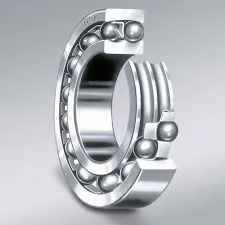
2 月 . 20, 2025 12:02 Back to list
Deep Groove Ball Bearings
Deep groove ball bearings stand out as one of the most commonly used bearing types in the world, acclaimed for their versatility and efficiency. These bearings find their place in a myriad of applications, ranging from household appliances to sophisticated industrial machinery. Understanding their standard sizes and choosing the right specifications is crucial for ensuring optimal performance and durability.
While sizes are standardized, deep groove ball bearings can be enhanced through material selection and sealing options. Standard bearings are typically made from chrome steel, offering a balance of strength and shock resistance. However, applications such as food processing or marine environments may require stainless steel or ceramic options to combat corrosion and contamination. Seals and shields further augment a bearing's performance. Rubber seals provide excellent protection against dirt and moisture, extending the bearing's lifespan in harsh conditions. Conversely, metal shields offer moderate protection but facilitate higher speeds by reducing rotational friction. Performance and Reliability through Precision Deep groove ball bearings are engineered for precision, a factor paramount to their reliability and efficiency. The precision levels are defined by the tolerance standards specified in ISO 4922014 and are crucial for applications demanding high accuracy, such as aerospace and instrumentation. Precision-rated bearings minimize vibrational impact and reduce noise, enhancing the overall equipment performance. Innovation and the Future of Bearing Sizes The future of deep groove ball bearings promises innovations driven by technological advancements. The emergence of smart bearings equipped with sensors for predictive maintenance is expected to offer unprecedented levels of performance data. These developments will likely influence the standards and sizes of future bearings, emphasizing long-term sustainability and efficiency. Choosing a Reliable Supplier Selecting a trusted supplier is as critical as choosing the right bearing size. A reliable supplier offers expertise, ensuring products meet stringent quality standards. Many suppliers provide detailed specifications, technical support, and post-purchase service, reinforcing product trustworthiness and customer satisfaction. In conclusion, the landscape of deep groove ball bearings is defined by their standard sizes, materials, and technological advancements. Mastery of these elements ensures that products meet evolving market demands, offering reliability, efficiency, and longevity. Whether for a simple household appliance or a complex industrial system, understanding the nuances of deep groove ball bearing sizes equips engineers and manufacturers to make informed, strategic decisions.


While sizes are standardized, deep groove ball bearings can be enhanced through material selection and sealing options. Standard bearings are typically made from chrome steel, offering a balance of strength and shock resistance. However, applications such as food processing or marine environments may require stainless steel or ceramic options to combat corrosion and contamination. Seals and shields further augment a bearing's performance. Rubber seals provide excellent protection against dirt and moisture, extending the bearing's lifespan in harsh conditions. Conversely, metal shields offer moderate protection but facilitate higher speeds by reducing rotational friction. Performance and Reliability through Precision Deep groove ball bearings are engineered for precision, a factor paramount to their reliability and efficiency. The precision levels are defined by the tolerance standards specified in ISO 4922014 and are crucial for applications demanding high accuracy, such as aerospace and instrumentation. Precision-rated bearings minimize vibrational impact and reduce noise, enhancing the overall equipment performance. Innovation and the Future of Bearing Sizes The future of deep groove ball bearings promises innovations driven by technological advancements. The emergence of smart bearings equipped with sensors for predictive maintenance is expected to offer unprecedented levels of performance data. These developments will likely influence the standards and sizes of future bearings, emphasizing long-term sustainability and efficiency. Choosing a Reliable Supplier Selecting a trusted supplier is as critical as choosing the right bearing size. A reliable supplier offers expertise, ensuring products meet stringent quality standards. Many suppliers provide detailed specifications, technical support, and post-purchase service, reinforcing product trustworthiness and customer satisfaction. In conclusion, the landscape of deep groove ball bearings is defined by their standard sizes, materials, and technological advancements. Mastery of these elements ensures that products meet evolving market demands, offering reliability, efficiency, and longevity. Whether for a simple household appliance or a complex industrial system, understanding the nuances of deep groove ball bearing sizes equips engineers and manufacturers to make informed, strategic decisions.
Latest news
-
Unlocking Efficiency with Spherical Roller Bearings
NewsOct.29,2024
-
The Ultimate Guide to Thrust Ball Bearings
NewsOct.29,2024
-
The Power of Thrust Roller Bearings: Engineered for Excellence
NewsOct.29,2024
-
The Power of Deep Groove Ball Bearings for Your Application Needs!
NewsOct.29,2024
-
The Power and Performance of Cylindrical Roller Bearings
NewsOct.29,2024
-
High-Quality Ball Bearing Manufacturing Machines
NewsOct.29,2024
